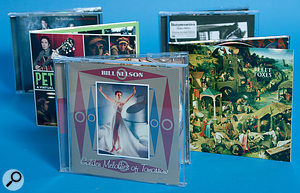Over the last couple of years I've mixed quite a lot of songs, but only single tracks here and there. Now I'm about to mix an album, and I'm wondering what would be the best way to do it. The recording has been done in a very decent studio, and they have been adding some programmed elements afterwards. I want to avoid a situation where I mix all the tracks so that they sound great on their own, only to realise later that they won't fit together as a whole. How would you approach this? Would you mix one track, and use it as a reference for the other mixes? Would you re‑use some of the settings (for example, use the same plug‑ins for the same tracks, with some tweaks)? Sadly, the budget doesn't allow for a separate mastering job, so I would have to do some limiting and final tweaks myself.
SOS Forum post
SOS contributor Mike Senior replies: If you're wanting a collection of tracks to fit together on your record, it makes sense to have some elements common to the different mixes, but at the same time you can't just duplicate your mix settings slavishly, because you also need to allow yourself enough flexibility to respond to each cut's unique mix‑processing needs as well, especially if the instrumentation changes radically from one to the next.
 If you're seeking a cohesive feel, the approach required for mixing an entire album of material will usually be somewhat different from that for mixing a single track.One strategy would be to identify some common arrangement elements that could be used as a kind of 'sonic anchor' for the production as a whole — something that appears in nearly every track, and which, if given a consistent sound signature, might conceptually glue all the tracks together. The lead vocals are an obvious choice in a lot of cases, as they are usually very prominent in the mix, and consistency in this department is often desirable for 'brand recognition' purposes. However, any other important instrument might just as readily fulfil this role too: drums and bass for a rock band, perhaps; acoustic guitar or piano for a singer‑songwriter; or the kick‑drum samples for a house or hip‑hop act.
If you're seeking a cohesive feel, the approach required for mixing an entire album of material will usually be somewhat different from that for mixing a single track.One strategy would be to identify some common arrangement elements that could be used as a kind of 'sonic anchor' for the production as a whole — something that appears in nearly every track, and which, if given a consistent sound signature, might conceptually glue all the tracks together. The lead vocals are an obvious choice in a lot of cases, as they are usually very prominent in the mix, and consistency in this department is often desirable for 'brand recognition' purposes. However, any other important instrument might just as readily fulfil this role too: drums and bass for a rock band, perhaps; acoustic guitar or piano for a singer‑songwriter; or the kick‑drum samples for a house or hip‑hop act.
The point, though, is that it would probably be a waste of effort to try to match everything between the different mixes — it would take you ages and wouldn't make the mixes any better, because you'd be torn between making an instrument sound the same as on the other tracks and making it sound the way it needs to in that specific mix. Duplicate your plug‑in settings for a couple of the most important elements (maybe vocals and bass), and then work from there, trusting yourself to 'fill in the blanks' on each mix as you would normally do, and tweaking the duplicated plug‑in settings as necessary to make each mix work in its own right. Remember that, if nothing else, your own personal mixing style will also contribute to a consistent overall sound.
Another thing which might help is to decide on a basic core line‑up of send effects (especially reverbs and delays), supplementing them with other effects specific to each mix as required. Even though you'll need to adjust the levels and reverb/delay times of these core effects to match the different mixes, their basic sound will otherwise remain fairly consistent, giving all the cuts on the record something of a common environment, whether real or unreal sounding. And again, don't be afraid to tweak the duplicated effects if that works better in each specific mix; just having started with them as they were will have helped put you in the same mindset as you were in on the previous mixes.
I would certainly reference the full mixes against each other as you work, but I'd leave this comparison until you've got a pretty good draft mix up and running in each case, otherwise it's easy to start chasing your tail with individual instrument levels. Once you have a good first draft of a mix, import it into a new sequencer project so that you can compare it not only with the other mixes you've done, but also with a selection of representative commercial mixes. The main things to look for here, in my experience, are the levels of certain key instruments such as drums, bass and vocals (as these can be very genre‑dependent) and the overall tonality of each mix. Be careful of getting too obsessed with other, more minor, details, as this is usually a good way to spend lots of time for very little reward! This referencing project will also help with getting suitable loudness levels if you're going to be taking on the responsibility for loudness processing in the absence of a mastering engineer.
